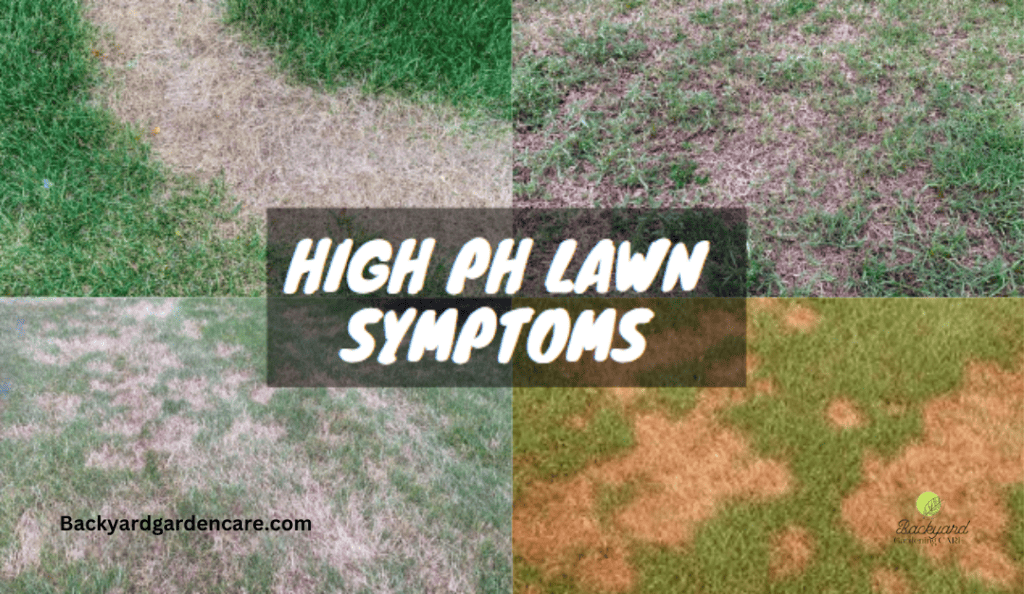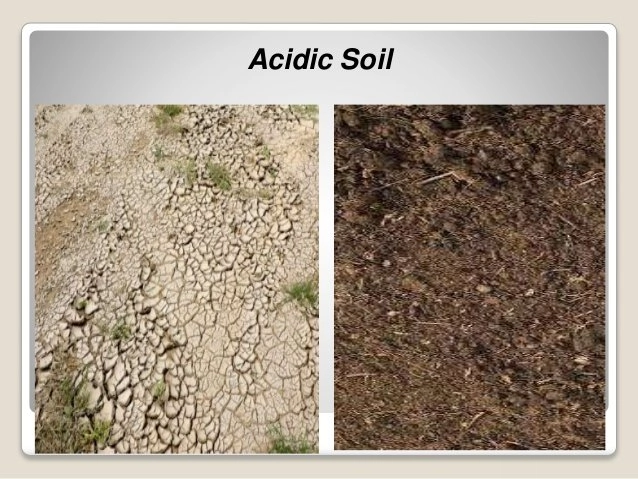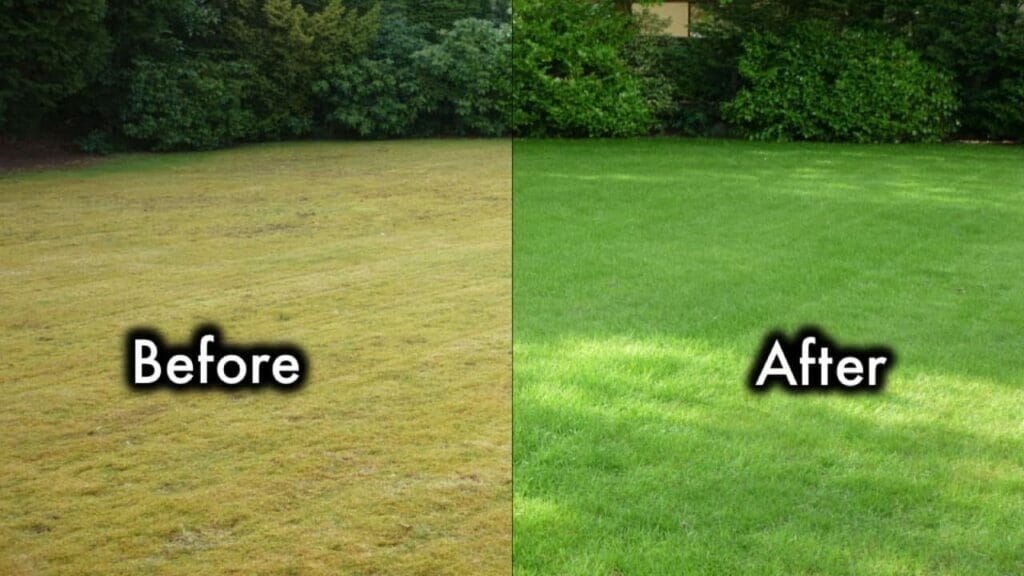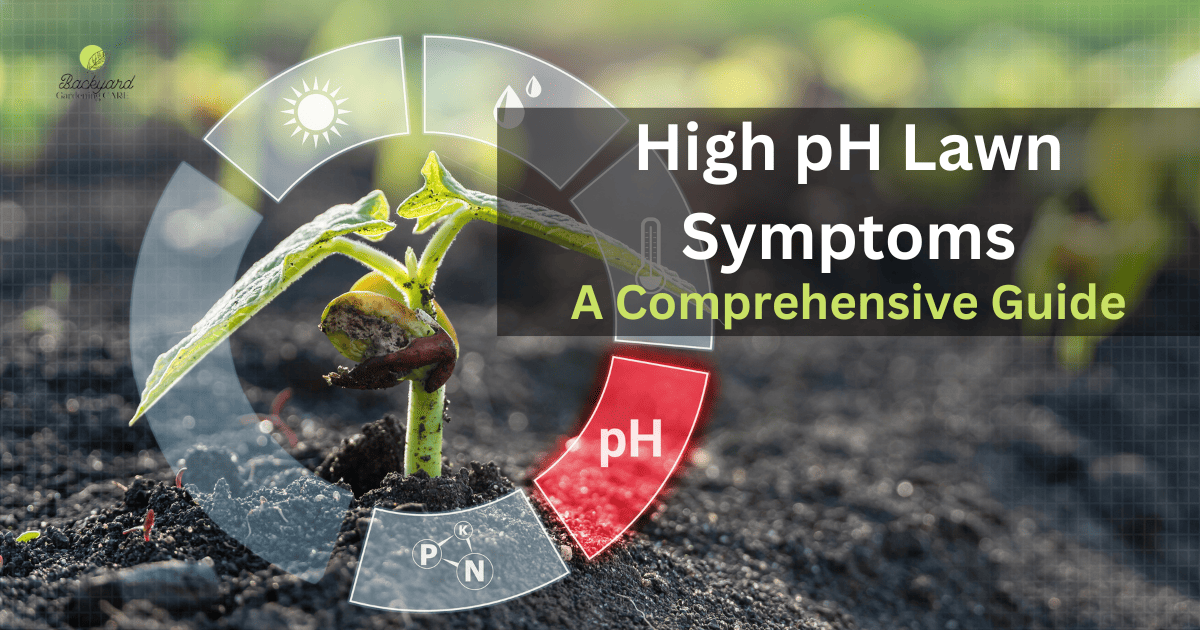High pH Lawn Symptoms Identifying and Treating: A Comprehensive Guide.
Maintaining a healthy and vibrant lawn is a top priority for many homeowners. It is important to note, however, that even with the best of care and attention, issues can arise that affect the overall health of the grass.
One common problem that homeowners may face is high pH levels in the soil, which can lead to various symptoms and challenges in lawn maintenance. When the pH of your lawn is too high, it can lead to nutrient loss, weed growth, and overall poor lawn health.
Identifying and treating high-pH lawn symptoms is essential to improving soil balance and maintaining a lush and thriving lawn. In this blog, we will explore the signs of high pH levels, the causes behind them, and the most effective treatments to fix the issue.

Whether you are an experienced gardener or a new homeowner, this guide will provide you with the knowledge and strategies to ensure a vibrant and beautiful lawn. Please read the following factors and solutions if you experience high ph lawn symptoms.
Understanding the Importance of pH Levels in Lawns.
Regularly watering and mowing your lawn is not enough to maintain a lush, healthy lawn. One crucial factor that often goes unnoticed is the soil’s pH level. The pH level is a measure of the acidity or alkalinity of the soil, and it plays a vital role in determining the overall health and appearance of your lawn.
In this section, we will explore the importance of pH levels in lawns and how you can ensure that your soil is at its optimum pH level for a thriving and vibrant lawn. Here are a few factors to consider and solutions if you notice high ph lawn symptoms.
What is pH?
The pH of your soil is an essential factor in determining the health and growth of your lawn. In simple terms, pH refers to the level of acidity or alkalinity present in your soil. The term pH stands for “potential hydrogen,” which directly relates to the concentration of hydrogen atoms in your soil.
The pH scale ranges from 0 to 14, with the optimal level falling right in the middle at pH 7. A pH value of 7 indicates that your soil is perfectly balanced, allowing your lawn to thrive and grow successfully.
When the pH level exceeds 7, typically 8 to 14, the soil is classified as alkaline. Conversely, the soil is considered acidic if the pH level falls below the neutral point, ranging from 6 to 0. Both acidic and alkaline soil can create various challenges for your grass and plants.
Acidic soil can hinder the growth of your lawn and plants by limiting nutrient availability resulting in stunted growth and poor health. Furthermore, acidic soil can lead to an imbalance in beneficial soil microorganisms, further impacting the overall well-being of your lawn.
On the other hand, alkaline soil poses its own set of problems. It can cause certain nutrients to become locked up in the soil, making them unavailable to plants. This nutrient deficiency can lead to yellowing leaves, stunted growth, and an overall decline in the health of your lawn.
Understanding the pH of your soil is crucial for maintaining a healthy and thriving lawn. By knowing whether your soil is acidic or alkaline, you can make informed decisions regarding fertilizer application and soil amendments.
Adjusting the pH of your soil can help optimize nutrient availability and create a more beneficial environment for your plants. Regular soil testing is recommended to determine the pH level of your soil.
This can be done through DIY test kits or by sending a soil sample to a professional laboratory for analysis. Once you have the results, you can take the necessary actions to adjust the pH if needed.
Maintaining the proper pH level in your soil is crucial to ensure optimal conditions for your lawn and plants. Regular soil testing can help you identify any pH problems and take appropriate measures to correct them.
The Difference Between Acidic and Alkaline Soils.

Soil is the foundation of life; It provides the nutrients and support necessary for plants to grow and thrive. However, not all soils are created equal. One of the key differences among soils is their pH level, which can be either acidic or alkaline.
Understanding the difference between these two types of soils is crucial for successful gardening and agriculture. Here we will explore the characteristics of acidic and alkaline soils, their impact on plant growth, and how to determine and adjust the pH of your soil.
Acidic Soil
Acidic soil is a common problem in gardening and can have detrimental effects on plant growth. It occurs due to various factors, such as leaching and decomposition.

When heavy rains wash away calcium and magnesium from the soil, it decreases the pH level, making the soil acidic. Moreover, the presence of certain minerals and chemicals can also contribute to the rise in acid levels.
When the soil becomes acidic, it becomes toxic to certain plants as it harbors an excess of elements like carbon dioxide, nitric acid, and sulfuric acid. These elements can shock and kill plants sensitive to acidic conditions.
Therefore, it is crucial to monitor and maintain the pH balance of the soil to ensure healthy plant growth. Several factors can contribute to the acidity of the soil. If not properly applied, chemical fertilizers can lead to over-fertilization, which can “burn” the plants and increase soil acidity.
Similarly, heavy or acid-ridden rains can cause nutrient leaching, where essential nutrients are washed away in the runoff, further increasing the acidic conditions of the soil. Another factor that can increase soil acidity is the type of black mulch used.
It’s possible that certain types of mulch can release acidic compounds as they decompose, which can lower soil pH. Therefore, choosing the right mulch type that will not contribute to soil acidity is important.
Even the use of pesticides can affect the pH levels of the soil. Some pesticides contain chemicals that can alter the soil’s natural balance, leading to acidic conditions.
It is essential to use pesticides judiciously and opt for organic alternatives whenever possible to minimize the impact on soil acidity. To address the issue of acidic soil, it is recommended to regularly test the pH levels of the soil and take appropriate measures to correct the imbalance.
Adding lime to the soil can help neutralize the acidity and restore the pH level to a suitable range for plant growth. Further, mixing organic matter into the soil can improve its structure and nutrient content, promoting a healthier environment for plants.
Alkaline Soil
Alkaline soil, also known as “sweet” soil, is characterized by high levels of sodium, calcium, and magnesium. The high levels of sodium, calcium, and magnesium in alkaline soil can disrupt the absorption process and hinder the roots of plants from accessing the nutrients they need.

This, in turn, can cause problems for plants as their roots struggle to absorb the necessary nutrients from the soil. Alkaline soil is often found in areas that receive very little rainfall or in landscapes where the water supply contains high levels of lime.
This can result in a challenging environment for plants to thrive in. Understanding the characteristics of alkaline soil is crucial for gardeners and landscapers, as it can impact the health and growth of plants.
To make their plants more comfortable, gardeners must understand the composition of their soil and adjust its pH levels accordingly. Ultimately, understanding the difference between acidic and alkaline soils is essential for successful gardening and agriculture.
The soil’s pH level plays a crucial role in nutrient availability and overall plant health. By determining and adjusting the pH level, you can create an environment conducive to your desired plants’ growth.
Identifying High Ph Lawn Symptoms
Identifying high pH lawn symptoms is vital for maintaining a healthy and green lawn. Personally, I once noticed yellowing patches in my yard, and the grass looked weak and stunted. After testing the soil, I discovered that it had a high pH level, which was causing nutrient deficiencies in the grass. To rectify this, I applied sulfur to lower the pH, and over time, my lawn regained its vibrancy.
In discussing this with my friend Sara, a seasoned gardener, she stressed the importance of regularly testing soil pH and paying attention to the specific symptoms, as a high pH can hinder nutrient uptake, ultimately affecting the overall health and appearance of your lawn.
1. Yellowing Grass
One of the most noticeable symptoms of high pH in your lawn is yellowing grass patches. When the pH level rises above the optimal range, essential minerals like manganese, copper, zinc, boron, and iron, essential for the chlorophyll molecule responsible for photosynthesis and leaf color, are deficient in an alkaline environment.
This nutrient deficiency leads to yellowing grass blades, giving your lawn a lackluster appearance.
Even though the overall quality of your grass may not seem affected, the yellowing clearly indicates missing nutrients. Another sign to watch out for is the presence of holes or dead patches in your lawn.
2. Stunted Growth
High pH levels can hinder the lawn’s ability to absorb crucial nutrients which are necessary for healthy growth; it can lead to a deficiency of other vital nutrients, such as nitrogen and iron.
Without these nutrients, grass growth can be severely impacted, resulting in stunted growth and thinning turf. If you notice that your lawn is struggling to fill in bare patches or seems to be growing at a slower rate than usual, it may be a sign of high pH.
3. Weeds Thriving
It is easy for weeds to plant themselves in your lawn and take advantage of it rapidly. High pH levels create an environment that is unfavorable for your grass but favorable for many weed species.
It is possible that high soil pH is causing an increase in weed growth in your garden, especially if you notice broadleaf weeds growing more frequently.
4. Moss and Algae Growth
A high pH level can create an environment that is conducive to moss and algae growth. These plants thrive in acidic conditions and can quickly take over your lawn, killing the grass and creating an unsightly appearance. If you notice patches of moss or algae in your lawn, it could indicate a high pH issue.
5. Poor Stem Growth
Another indicator of alkaline soil is poor stem development in your grass. A healthy lawn will have a robust and vibrant flow system running through the plant. This system ensures that nutrients are properly absorbed and distributed.
However, when the soil is too alkaline, the grass may struggle to develop strong stems, hindering its overall growth and health.
Understanding the symptoms of high pH in your lawn is crucial for maintaining its overall health and vitality. You can ensure that your grass thrives by being proactive and taking the necessary steps to address this issue.
Signs of Low Ph in Soil
When it comes to maintaining a healthy lawn, the soil’s pH level plays a crucial role. Low pH levels in the soil can have detrimental effects on the overall health and appearance of your lawn.
One of the most noticeable signs of low pH in the soil is the lack of support for neutral or alkaline plants. Instead, various types of weeds and moss tend to thrive in such conditions, making your lawn look untidy and unkempt.
Additionally, soil quality starts to decline as pH drops. This can be observed through the yellowing of grass, which is a common symptom of low pH. The grass loses its vibrant green color and becomes weak and sickly.
On the other hand, certain tree types, like oak and pine, tend to thrive in acidic soil conditions. So, if you notice these trees growing better than the grass in your lawn, it might be an indication of low pH levels in the soil.
Low pH in the soil can also cause fungal diseases in your lawn, such as leaf blight and visual cues. It is important to note that these diseases thrive in acidic environments and can devastate your lawn’s plants.
Leaf blight can cause discoloration, wilting, and even death of plants if left ignored. Therefore, it is essential to pay attention to the pH level of your soil to prevent the spread of such fungal diseases.
How to Increase Lawn Ph?
If you are struggling with maintaining your lawn’s pH level, a simple solution can work wonders lime. Lime is known to replace hydrogen ions in the soil, effectively raising its pH level.
Acidic soils, which can be caused by excessive decaying organic matter and the use of ammonium and sulfur fertilizers, can have detrimental effects on your lawn.
However, lime can come to the rescue in multiple ways. One of the benefits of lime is that it provides your plants with essential nutrients such as calcium and magnesium. Calcium and magnesium are vital nutrients for the health and resilience of your lawn.
They play a crucial role in helping your plants withstand various environmental stresses, including high temperatures, drought, and heavy snow or rainfall.
By increasing the availability of calcium and magnesium through liming, you can enhance your lawn’s overall strength and vitality.

Lime not only provides nutrients but also increases the availability of nitrogen in the soil. Nitrogen is a vital nutrient required for healthy plant growth and development.
Lime aids in the decomposition of organic matter, which in turn accelerates the release of nitrogen into the soil. This allows your plants to access this essential nutrient more readily, promoting their overall health and vigor.
The mineral lime is not only a source of essential nutrients, but it can also counteract decaying organic matter as well as oxidative stress associated with ammonium and sulfur fertilizers.
Too much decaying organic matter can lead to soil acidity, while certain fertilizers can further contribute to this problem. Lime acts as a balancing agent, neutralizing the acidifying effects and creating a more favorable environment for your plants.
When applying lime to your lawn, it’s important to follow the recommended guidelines based on your soil type and pH level.

It’s best to conduct a soil test to determine the amount of lime needed to achieve the desired pH level. Applying too much lime can have adverse effects, so it’s essential to be cautious and follow expert advice.
Choosing the Right Lime for Your Soil
When choosing the right type of lime for your soil, it’s important to understand the options available. There are several types of lime to choose from agricultural lime, calcitic lime, dolomitic lime, hydrated lime, and more.

Each type offers its own unique benefits and reacts differently with different types of grasses. Ground dolomite lime is one of the most common types sold for lawns. This type of lime is rich in calcium-magnesium carbonate, making it a great source of these essential nutrients for your soil.
Although, shopping for lime can be confusing for the average homeowner, who may need to become more familiar with mineral-related terminology and the specific benefits of each type of lime.

It’s important to do some research and understand the specific needs of your soil and grass before making a decision. Different types of lime may be more suitable for certain soil conditions or different grass varieties.
Some grasses may require higher magnesium levels, while others may benefit from higher calcium levels. Consulting with a professional or seeking advice from a local gardening center can also be helpful in determining the best type of lime for your specific needs.
Overall, choosing the right type of lime for your soil is an important step in maintaining a healthy and thriving lawn.

With various options available, it’s essential to understand each type’s different benefits and reactions. By doing your research and seeking expert advice, you can make an informed decision that will contribute to the long-term success of your lawn.
Conclusion.
Understanding the symptoms of high pH in lawns is essential for maintaining a healthy and vibrant outdoor space. By recognizing the signs early on, such as yellowing grass, stunted growth, and moss or weeds taking over, homeowners can take the necessary steps to correct the pH imbalance.
Whether through proper soil testing, adjusting fertilization practices, or implementing lime applications, addressing high pH levels can help restore and improve the overall health of the lawn.
FAQs
What Happens to Grass if Ph is Too High?
If the pH of the soil is too high, the grass can suffer from nutrient deficiencies. High pH levels can limit the availability of essential nutrients like iron, manganese, and zinc, which are necessary for healthy grass growth.
This can result in yellowing or browning of the grass, stunted growth, and overall poor health. It is important to adjust the pH of the soil to an optimal range for healthy grass growth.
How Do I Fix High Ph on My Lawn?
To fix the high pH in your lawn, there are a few steps you can take. First, test the soil pH to confirm the high levels. Then, apply a soil amendment specifically designed to lower pH, such as sulfur or aluminium sulfate.
Ensure that you follow the application rate instructions on the product. Watering your lawn regularly and deeply is also important to help flush out excess alkalinity.
Furthermore, avoid using alkaline fertilizers and consider incorporating organic matter into the soil to improve its overall health. Regular soil testing and monitoring will help you maintain the proper pH level for a healthy lawn.
What Are Signs of High Ph Soil?
Signs of high pH soil include the presence of certain weed species, such as clovers and weeds, as well as the yellowing of leaves on plants, nutrient deficiencies, reduced availability of certain essential elements, and an increased risk of certain plant diseases.
Additionally, the soil may feel dry and crumbly, and certain nutrients like iron, manganese, and phosphorus may become less available to plants.
What is the Ph Range for Lawns?
The optimal pH range for lawns is between 6.0 and 7.0. This slightly acidic to neutral pH level allows for proper nutrient absorption by the grass and promotes healthy growth. It is important to regularly test and adjust the pH of your lawn to ensure optimal conditions for your grass to thrive.
Best Ph for Fescue Grass?
The best pH for fescue grass is typically between 5.5 and 7.5. Fescue grasses prefer slightly acidic to neutral soil conditions. Testing the soil pH before planting fescue grass is important to ensure it is within this optimal range. If the soil pH is too low or too high, amendments can be made to adjust it to the ideal levels for fescue grass growth.
Jack Ralph

hey, I’m Jack Ralph, a dedicated grass and lawn expert with years of experience creating beautiful outdoor spaces. I can help you achieve the lawn of your dreams, from seeding to mowing, turning your yard into a natural masterpiece.
Look no further—I’m the key to transforming your lawn dreams into reality! and here to help you achieve a lawn that’s not just a patch of grass, but a canvas of natural artistry.







